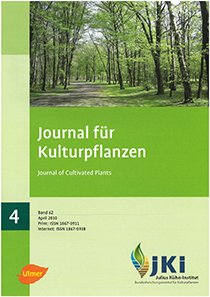Measuring late blight attack of potato foliage in field trials: optimal resource allocation in assessment trials
Keywords:
Solanum tuberosum, Phytophthora infestans, AUDPC, field trial, variance componentsAbstract
An empirical data set was analysed in order to give recommendations on the optimal resource allocation in a field testing system to measure late blight attack in potato. The data set was derived from an experiment comprising 854 genotypes, three years, two replicates per year, and 16 to 18 scoring dates per year. AUDPC (area under disease progress curve) values were calculated based on percentage of attacked haulm. Artificial inoculation was used to establish late blight in the testing field. Three testing years, two replicates per year, and three scoring dates per year are recommended to be sufficient. The results are based on the assumption, that the quality of data is independent of the frequency of data collection. This assumption is critically discussed.
DOI: 10.5073/JfK.2010.04.02, https://doi.org/10.5073/JfK.2010.04.02








